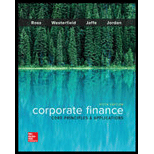
To discuss: The three types of business organizations, merits and demerits of each organizations and what form of business take more start-up and why.
Explanation of Solution
The three types of business organizations is as follows:
- Sole proprietorship
Partnership - Corporation
The advantages of sole proprietorship is as follows:
- Less paper work
- Simplified tax setup
- Lesser business fees
- Less cost of formation
- Simplified business proprietorship
The advantages of partnership is as follows:
- Less cost of formation.
- More cash
- More opportunities to business
- Cost savings
The advantages of corporation is as follows:
- Limited liability
- Easy to transfer ownership
- Admittance to capital market
- Continuous existence
The disadvantages of sole proprietorship is as follows:
- Difficulty in contributing large capital
- Restricted life
- Liability is unlimited
The disadvantages of partnership is as follows:
- Liability is unlimited
- Restricted life
- Difficulty in transmitting ownership
The disadvantages of corporation is as follows:
- Double
taxation of incomes - Obligation to file state and federal reports for registering is expensive
- Complex and time consuming
In case of starting a new business, the most take form is partnership or sole proprietorship for the reason that it is very easy to start these types of business.
Want to see more full solutions like this?
Chapter 1 Solutions
Corporate Finance: Core Principles and Applications (Mcgraw-hill Education Series in Finance, Insurance, and Real Estate)
 Essentials Of InvestmentsFinanceISBN:9781260013924Author:Bodie, Zvi, Kane, Alex, MARCUS, Alan J.Publisher:Mcgraw-hill Education,
Essentials Of InvestmentsFinanceISBN:9781260013924Author:Bodie, Zvi, Kane, Alex, MARCUS, Alan J.Publisher:Mcgraw-hill Education,

 Foundations Of FinanceFinanceISBN:9780134897264Author:KEOWN, Arthur J., Martin, John D., PETTY, J. WilliamPublisher:Pearson,
Foundations Of FinanceFinanceISBN:9780134897264Author:KEOWN, Arthur J., Martin, John D., PETTY, J. WilliamPublisher:Pearson, Fundamentals of Financial Management (MindTap Cou...FinanceISBN:9781337395250Author:Eugene F. Brigham, Joel F. HoustonPublisher:Cengage Learning
Fundamentals of Financial Management (MindTap Cou...FinanceISBN:9781337395250Author:Eugene F. Brigham, Joel F. HoustonPublisher:Cengage Learning Corporate Finance (The Mcgraw-hill/Irwin Series i...FinanceISBN:9780077861759Author:Stephen A. Ross Franco Modigliani Professor of Financial Economics Professor, Randolph W Westerfield Robert R. Dockson Deans Chair in Bus. Admin., Jeffrey Jaffe, Bradford D Jordan ProfessorPublisher:McGraw-Hill Education
Corporate Finance (The Mcgraw-hill/Irwin Series i...FinanceISBN:9780077861759Author:Stephen A. Ross Franco Modigliani Professor of Financial Economics Professor, Randolph W Westerfield Robert R. Dockson Deans Chair in Bus. Admin., Jeffrey Jaffe, Bradford D Jordan ProfessorPublisher:McGraw-Hill Education





